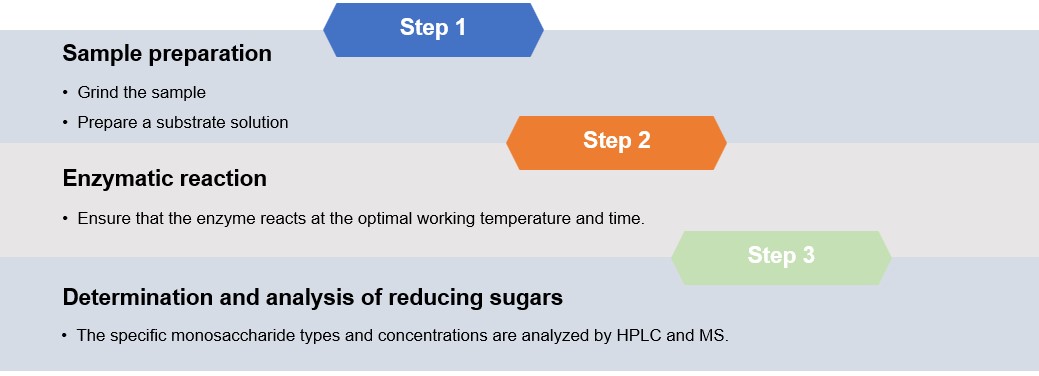Cellulolytic Enzyme Activity Assessment Service
High-quality Activity Assessment of Cellulolytic Enzymes at Creative Biolabs
Cellulolytic enzymes are produced by many microorganisms (such as fungi and bacteria) in nature. It is a general name for a class of enzymes used to hydrolyze cellulose and other cellulosic substances. These enzymes break down complex cellulose polymers into smaller soluble sugar units. The main ingredients include:
-
Cellulase: It includes multiple subtypes, such as endoglucanase, exoglucanase, and β-glucosidase, which can break down cellulose into glucose monomers.
-
Hemicellulase: It can hydrolyze hemicellulose into various monosaccharide units, such as xylose, arabinose, etc.
-
Other enzymes: There are some enzymes, such as xylanase and pectinase, which play a synergistic role in the degradation of cellulose.
Creative Biolabs has many years of experience in Glyan-related Enzyme Activity Analysis. Our professional scientific research team provides clients with diversified analysis services, such as Biomass Enzyme Degradation Efficiency Analysis, Enzyme-Mediated Saccharification Efficiency Analysis, Amylolytic Enzymes, and cellulolytic enzyme activity analysis services. For the analysis of cellulolytic enzyme activity, we usually proceed through the following steps:
We grind the sample we want to analyze to increase the surface area. Then, an appropriate cellulose substrate, such as carboxymethyl cellulose (CMC) or other cellulose derivatives, is prepared into a substrate solution of appropriate concentration.
We put the mixed pretreated sample and substrate solution in the same reaction system, and add cellulolytic enzymes, such as cellulase, β-glucosidase, etc. Ensure that the enzyme reacts at the optimal working temperature by controlling the reaction temperature and time. Then add an acidic or alkaline solvent to the reaction system to stop the enzyme reaction.
-
Determination and analysis of reducing sugars
We react the product with 3,5-dinitrosalicylic acid (DNS) to produce a colored product and calculate the concentration of reducing sugar by measuring the content of the colored product. In addition, we analyze the specific monosaccharide types and concentrations in the products through high-performance liquid chromatography (HPLC) and mass spectrometry (MS). Finally, we calculate the activity of the enzyme according to the amount of reduced sugar produced, usually using the amount of reduced sugar released per unit of time as an indicator.
 Fig.1 Detailed steps for cellulolytic enzyme activity assessment.
Fig.1 Detailed steps for cellulolytic enzyme activity assessment.
These steps help clients analyze the activity of cellulolytic enzymes under specific conditions. Creative Biolabs quickly responds to client needs and is committed to providing high-quality, professional cellulolytic enzyme activity analysis services to meet clients' needs and provide support for research and applications in related fields. Please contact us if you need to obtain detailed content.
Published data
Commercial cellulolytic enzymes are expensive. The authors discovered a source of enzymes capable of degrading fibrous feed through this study. The author isolated the Enterobacter cloacae strain from bovine rumen fluid and placed it in a liquid culture medium to obtain the target cellulolytic enzyme from the colony and measure its activity. The authors placed the medium in a shaker and cultured E. cloacae at 35°C. Next, the culture was centrifuged to obtain a supernatant containing cellulolytic enzymes, and the activities of three cellulolytic enzymes in the supernatant were measured. The authors used a spectrophotometer to measure endo-(1,4)-β-D-glucanase, exo-(1,4)-β-D-glucanase, and β-glucocidase activity by colorimetry. The results showed that their enzyme activities were 0.09 U/ml, 0.13 U/ml, and 0.10 U/ml respectively.
Table 1 Enzyme activity detection results in E. cloacae.1, 2
|
Enzyme
|
Specific substrates
|
Activity (U/ml)±SD
|
|
Endo-(1,4)-β-D-glucanase
|
DNS
|
0.09±0.00027
|
|
Exo-(1,4)-β-D-glucanase
|
p-nitrophenyl cellobioside (pNPC)
|
0.13±0.0131
|
|
β-Glucocidase
|
p-nitrophenyl-β-D-glucopyranocide (pNPG)
|
0.10±0.0069
|
FAQs
Q1: How do you test the efficiency of cellulase degradation of cellulose?
A1: We evaluate the efficiency of cellulose degradation by cellulases by measuring the production of reducing sugars or other metabolites.
Q2: How do you deal with the impact of inhibitory substances that may be present in the sample on cellulolytic enzyme activity?
A2: Before performing cellulolytic enzyme activity analysis, we perform appropriate pretreatment steps on the sample, such as dilution, washing, or removal of potential inhibitory substances. Or by adding specific deactivators or chelating agents to neutralize or degrade inhibitory substances, thereby reducing their impact on cellulolytic enzyme activity. In addition, we use standard materials or internal standard materials as reference materials, which can help eliminate the interference of inhibitory substances on experimental results.
Q3: Could you differentiate between the activities of different types of cellulases (β-glucosidase, endoglucanase, etc.)?
A3: Yes, we distinguish different types of cellulolytic enzyme activities, such as β-glucosidase and endoglucanase, through specific substrate reactions or experimental conditions. β-glucosidase mainly targets the monosaccharide binding site, while endoglucanase acts more inside the cellulose chain. Therefore, the appropriate selection of substrates can reflect the differences in the activity of different types of cellulolytic enzymes.
Customer Review
Professionalism and Accuracy
"Creative Biolabs's analytical team is very professional. The cellulolytic enzyme activity analysis results they provided are accurate and help us gain a deep understanding of the efficiency of enzymes in the process of degrading cellulose."
Efficient Delivery
"The Creative Biolabs team is extremely efficient, and they completed the experiment in a short time and delivered the data promptly. The report is detailed clear and easy to understand. The presentation of the cellulolytic enzyme activity analysis results allowed us to have a comprehensive understanding and evaluation of the experimental results, which saves valuable time in our research work."
References
-
Lokapirnasari, Widya Paramita, et al. "Production and assay of cellulolytic enzyme activity of Enterobacter cloacae WPL 214 isolated from bovine rumen fluid waste of Surabaya abbatoir, Indonesia." Veterinary World 8.3 (2015): 367.
-
Under Open Access license CC BY 2.0, without modification.
For Research Use Only.
Related Services

 Fig.1 Detailed steps for cellulolytic enzyme activity assessment.
Fig.1 Detailed steps for cellulolytic enzyme activity assessment.

